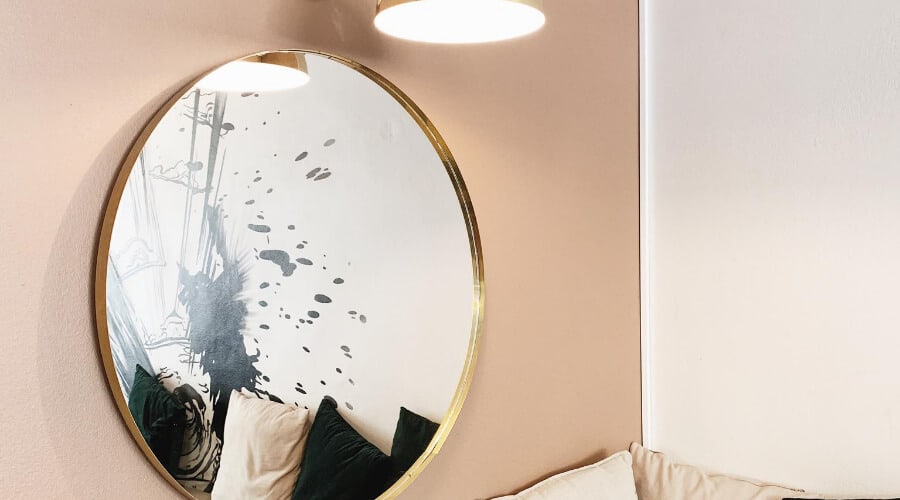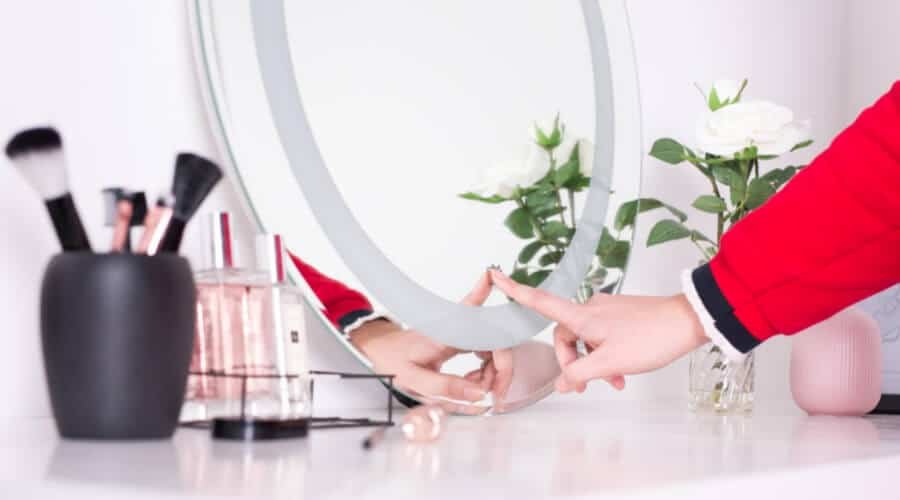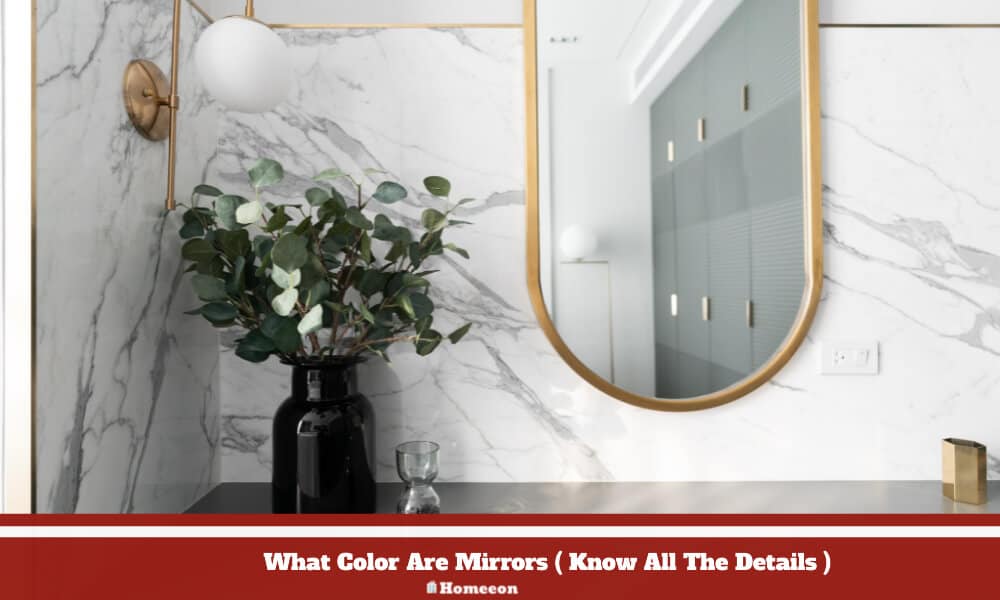Last Updated on July 25, 2023 By Emma W. Thomas
Mirrors are green in color with a silver backing, made from a Soda-lime silica glass substrate. This soda-lime mixture mirrors their color since the atoms in the glass reflect green light more strongly than other colors; its surface atoms give any reflection a very slight green tinge.
The Structure Of A Mirror

The structure of a mirror is what supplements and gives it its color. It is most often glass known as float glass, with a most likely flat, uniform surface. This type of glass is commonly found in many products, apart from mirrors such as window panes. It is made with soda lime and frequently used when making a mirror, contributing to the subtle green tint on the glass.
Mirrors are made with either polished aluminum or silver behind the float glass used as the actual reflective surface. Some might even include a mercury coating in a technique referred to as mercury silvering to create a continuously moving reflective layer. Liquid mirrors that were used in the early 19th century for telescopes used gallium or liquid mercury. Those you have in the car or at home typically use aluminum as their reflective surface, while liquid mirrors are still used in space observatories today.
How Can You Tell The Colour Of A Mirror?

1. You can place two mirrors in front of each other to ascertain their green color. Subsequently, the image you’ll see is an endless reflection that looks like it stretches to infinity. There will be a green color if you carefully look at the back of the reflection, where the image turns into a speck of black. At this point, you’ll be seeing the authentic color of the glass. This is how most people verify mirrors to be green.
2. On the other hand, mirrors are silver in the illustrations in fairytale books. Mirror images online and in print ads are also noticeably silver. You’ll possibly come up with silver as well if you look in your mirror searching for one distinct color. When you look across one with a crack in it at an angle, you’ll also come up with the same outcome. Nonetheless, based on how a mirror is made, you will come up with the green or silver color as your conclusion.
3. You’ll find a highly polished metal surface having a frame to hold it all together. It has a silver hue placed under a piece of float glass, breaking it down into its essential components. If you look at it just from the right angle or when it cracks, you will see the silvery layer. Therefore, it is not incorrect to answer silver is the color of the mirror.
4. You are not wrong either suppose you have ever thought that mirrors are white. White is the only color that reflects all of the visible wavelengths of the color spectrum, so you are still correct. Scattering the light, they reflect off in several different directions is most surfaces, such as a plain white wall or white paper. However, a mirror will replicate the light in the same direction from which it comes.
How do mirrors work?
Mirrors work based on the principle of reflection. They have a smooth, highly reflective surface, usually made of glass with a thin layer of metal (such as aluminum) on the back.
1. The Basic Principle:
Mirrors gain their reflective capabilities from a simple physics theory — the law of reflection. The law states that the angle of reflection is identical to the angle of incidence, meaning, when light hits a mirror’s surface, it bounces off the mirror at the same angle it arrived.
2. The Science Behind the Reflection:
A mirror reflects light because its surface contains millions of tiny, flat surfaces. These surfaces are so smooth that when light strikes them, it bounces back instead of being absorbed or scattered.
3. The Reflective Layer:
The important part of a mirror is not the glass, but the reflective coating. Typically, this reflective coating is made of aluminum or silver. This coating is thinly applied to the back of a glass pane.
4. The Role of Glass and the Backing:
Although not the primary factor, glass plays a crucial role too. The glass provided a smooth clear layer for the reflective material to sit on. It eliminates any anomalies that could distort the reflected image. Besides this, mirrors often have a layer of paint or some sort of backing material applied to protect the aluminum or silver reflective layer.
5. The Creation of Visual Perception:
Mirrors create a sense of visual perception. The light that hits the mirror’s surface reflects off objects, enters our eyes, and the brain converts this information into the images we see in the mirror.
6. The Mirror and the Color of Light:
Interestingly, mirrors have the ability to reflect all colors of light equally. Because they don’t absorb certain wavelengths more than others, mirrors display objects with their inherent, true color.
7. Mirroring Vs. Reflection:
Although these terms are often used interchangeably, they are not the same on a scientific level. Mirroring maintains the orientation of the original light source, such as text in a book. In contrast, reflection includes a light source bouncing off a non-reflective surface.
8. The Mirror and Left-to-Right Reversal:
Mirrors are commonly thought to reverse images from left to right. However, they actually flip images front to back. It’s our perception that creates the illusion of a lateral inversion.
9. The Limitations of Mirrors:
Despite a mirror’s ability to reflect most of the light that strikes it, no mirror is 100% efficient. Some light usually gets absorbed by the glass as well. This explains why repeated reflections in multiple mirrors eventually fade.
10. The Wonder of Concave and Convex Mirrors:
The power of mirrors isn’t limited to flat surfaces. With the advent of technology, uniquely shaped mirrors such as concave and convex help us in many ways. Concave mirrors can magnify images, making them crucial in devices like telescopes and makeup mirrors. Convex mirrors, on the other hand, spread light out and create a wide field of view, making them vital for car wing mirrors and security purposes.
Why do mirrors flip everything horizontally?
Navigating the world of physics and trying to understand it can sometimes be a brain teaser. A simple yet intriguing physics puzzle is the way mirrors seem to reverse images horizontally. Here’s a list looking at this fascinating phenomenon.
1. Understanding the Concept of Reflection:
The term ‘flipping’ is somewhat misleading. Mirrors don’t flip images, they reflect light. An object appears to be flipped horizontally because we interpret the direction of the image based on our standard perception of up and down.
2. Left to Right vs Front to Back:
Mirrors don’t actually reverse left to right, but front to back. If you are facing north and raise your left hand, your mirror image appears to raise its right hand. However, it is still facing north, thus the mirror image is actually reversed along the axis perpendicular to the mirror.
3. Role of the Brain:
Our brain plays a crucial role in the way we perceive our reflection. It has the tendency to interpret information based on our standard sense of orientation. This process causes our mirror images to give the illusion of horizontal flipping.
| Concept of Reflection | Mirrors reflect light instead of flipping images. |
| Left to Right vs Front to Back | Images are reversed from front to back, not left to right. |
| Role of the Brain | Our brain’s interpretation creates the illusion of a flip. |
4. The Principle of Mirror Symmetry:
Mirrors follow a simple rule on symmetry, known as ‘mirror symmetry’. When you move laterally, your image moves laterally. If you move closer or farther, your mirror image follows suit. The mirror merely follows your moves and direction, it doesn’t flip or invert things.
5. Evolution of Perceptions:
Our ancestors’ perception of reflections on water or shiny objects, where the image is inverted from top to bottom, may have influenced our perception of reflections and mirrors. This evolutionary view illustrates why we may see a perceived horizontal flip.
6. The Perception of Text:
When text is viewed in a mirror, it appears reversed. This happens due to the front-to-back reversal we see in mirrors. Because the text is typically organized from left to right in a specific order, it seems to be flipped when you view its reflection.
| Mirror Symmetry | Mirrors follow the rule of mirroring movements, not flipping. |
| Evolution of Perceptions | Historical context could influence our interpretation of mirrored images. |
| Perception of Text | Text appears reversed in mirrors due to front-to-back reversal. |
Just remember, mirrors aren’t the culprits for flipping images horizontally. Instead, the interaction between mirrors, our eyes, and our brain creates a fascinating illusion responsible for this curious perception.
Types Of Mirrors
I’m sure you have ever wondered about the various types of mirrors. The shape, reflective materials, support, manufacturing methods, and intended application can be used to determine the classification of mirrors. Have a look at the following table:
| By shape | Concave, convex, and planar. | A part of a sphere is the surface of curved mirrors. Typically made in the shape of a paraboloid of revolution, they’re used in solar furnaces, antennas to communicate with broadcast satellites, and telescopes from radio waves to X-rays. They are intended to concentrate parallel rays of light into a point precisely. A circular or parabolic cylinder is for mirrors that tend to focus sunlight onto a long pipe. |
| By reflective material | Non-linear optical mirrors | a phase-conjugating mirror uses non-linear optics to reverse the phase difference between incident beams. For coherent beam combination, such mirrors may be used. In imaging systems, correction of atmospheric distortions and self-guiding of laser beams are some practical applications. |
| By structural material | Flexible mirrors | They cannot shatter or produce sharp flakes and are sometimes used for safety. By stretching them on a rigid frame, their flatness is usually attained. Between two thin layers of transparent plastic, they consist of a film of evaporated aluminum. |
| Front-silvered mirrors | These are made of any rigid material, reflective on the front surface, which is the same side of the reflected light and the incident. A translucent protective coating is added on top of the reflecting layer To absorb specific wavelengths and protect them against corrosion, tarnishing, and abrasion. | |
| Back-silvered mirrors | Supported by a protective coating from corrosion, tarnishing, and abrasion, they consist of a transparent glass plate with a thin reflective layer on the back. This is the opposite side to the reflected light and incident. Other transparent materials may be used for specific applications, and lead glass used for decorative effects since the glass is usually soda-lime glass. For lighter weight or impact resistance, a plate of transparent plastic may be used instead of glass. A flexible transparent plastic film may be alternatively bonded to the front or the back surface of the mirror To prevent injuries if the mirror is broken. With an anti-reflection coating on the front Zsurface, lettering or decorative designs may be formed or printed on the reflective film. |
Uses Of Mirrors
1. Personal Grooming:
Mirrors may be handheld, adjustable, fixed, or mobile, ranging from small sizes that can be carried or full-body sizes.
2. Viewing Items That Are Not Directly Visible Due To Obstruction:
For example, dentist’s mirrors, security mirrors in or around buildings, and rear-view mirrors in vehicles.
3. Signaling:
Often used in military survival kits, specialized types of mirrors are also available. They attract the attention of search and rescue parties as part of their use.
4. In Scientific And Optical Apparatus:
This includes periscopes, telescopes, lasers, industrial machinery, and cameras.
5. Convex Mirrors:
They provide a wider field of view than flat mirrors and are used to minimize blind spots in vehicles such as large trucks. Allowing people to see around corners and avoid crashing into shopping carts or other vehicles, they’re placed at road junctions and corners of sites such as parking lots. For a single video camera to show more than one angle at a time, they’re used as part of security systems.
6. Dental Mirrors:
dentists frequently use dental or mouth mirrors to allow indirect vision and lighting into the mouth. They allow vision in tight spaces around corners in equipment since they’re also used by mechanics, with either flat or curved reflective surfaces.
7. Rear-View Mirrors:
Rear-view mirrors are used in and on vehicles such as bicycles and automobiles, allowing drivers to see the other cars coming right behind them. The left end of the left glass and the right end of the right glass work as mirrors on rear-view sunglasses.
8. One-Way Mirrors:
Overwhelming dim transmitted light with bright reflected light, these mirrors are also called
two-way mirrors. A true one-way mirror can’t allow light to be transmitted in one direction without requiring external energy, irreverent to the second law of thermodynamics.
9. One-Way Windows:
Without violating the second law, these windows can be made to work with polarized light in the laboratory. Although it doesn’t allow a practical one-way mirror for use in the real world, this is an apparent paradox that stumped some great physicists. Commonly used with lasers, optical isolators are one-way devices.
10. Technology:
Many of the largest high-definition televisions and video projectors have microscopic mirrors as the core element. In rear-projection televisions, large mirrors are generally used.
Conclusion
Green-tinged glass over a silver reflective surface that mimics the white color’s properties is the primary household mirror you will find in your bedroom or bathroom. Capable of reflecting all the colors in the world, you can put all these components together and come up with a beautiful, functional mirror. Now you know what answer to give to the color of mirrors and how you can verify it. Go ahead and educate others as well. All the best.
References:
https://gizmodo.com/what-color-is-a-mirror-1725115120
https://www.sciencefocus.com/science/what-colour-is-a-mirror/
Emma is a graduate of Domestic Science or Family and Consumer Sciences (Home Economics) from the University of Wisconsin. She has 7 years of experience Working with the strategic section of BestBuy and now writing full-time for Homeeon.
From Managing the Home, Interiors, Cleaning, and Exteriors to Gardening and everything about Making A Home Liveable – is her passion and this Homeeon is the result of this.
Emma loves decorating her home with the best stuff found online. She cares about quality over anything and writes reviews about them here in Homeeon. Get in touch with her over Pinterest.
Keep reading her blogs.

